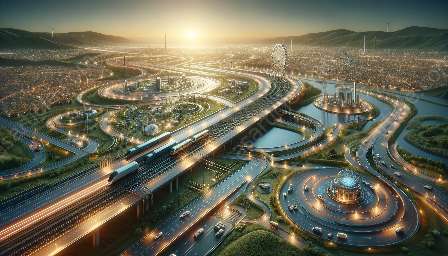In today's world, transportation plays a crucial role in connecting people and goods across the globe. However, the environmental impacts of transportation, particularly air pollution, cannot be ignored. This topic cluster will delve into the sources of air pollution from transportation, its detrimental effects on the environment, and the role of transport engineering in addressing these challenges.
Sources of Air Pollution from Transportation
Transportation is a significant contributor to air pollution, emitting various pollutants into the atmosphere. The primary sources of air pollution from transportation include:
- 1. Vehicle Emissions: Internal combustion engines in cars, trucks, and other vehicles emit pollutants such as carbon monoxide, nitrogen oxides, and particulate matter.
- 2. Aircraft Emissions: Airplanes release pollutants, including nitrogen oxides, sulfur oxides, and carbon dioxide, into the atmosphere.
- 3. Shipping Emissions: Maritime transportation contributes to air pollution through the emission of sulfur oxides, nitrogen oxides, and particulate matter.
- 4. Railway Emissions: Rail transport also generates air pollutants, such as nitrogen oxides and particulate matter, especially from diesel-powered locomotives.
Health and Environmental Effects of Air Pollution
The release of pollutants from transportation activities has far-reaching effects on both human health and the environment. Some of the key impacts include:
- 1. Public Health Impact: Poor air quality due to transportation-related pollution can lead to respiratory problems, cardiovascular diseases, and other health issues among the population.
- 2. Environmental Degradation: Air pollution contributes to the deterioration of air quality, soil, and water, impacting ecosystems and biodiversity.
- 3. Climate Change: Greenhouse gas emissions from transportation activities, particularly carbon dioxide, contribute to global warming and climate change.
- 1. Alternative Fuels: The development and implementation of alternative fuels, such as biofuels, hydrogen, and electric power, reduce the emission of pollutants from vehicles and other transportation modes.
- 2. Vehicle Efficiency: Transport engineering focuses on enhancing the efficiency of vehicles through advancements in engine technology, aerodynamics, and vehicle design to minimize emissions.
- 3. Public Transportation Systems: Designing and promoting efficient public transportation systems can reduce the number of individual vehicles on the road, leading to lower emissions and improved air quality in urban areas.
- 4. Infrastructure Development: Transport engineering professionals are involved in designing and implementing sustainable transportation infrastructure, including roads, bridges, and transit systems, to support cleaner and more efficient transportation.
Role of Transport Engineering in Mitigating Air Pollution
Transport engineering plays a pivotal role in addressing the environmental impacts of transportation, including air pollution. Some of the key strategies and technologies employed in transport engineering to mitigate air pollution include:
Conclusion
Air pollution from transportation is a pressing environmental issue that requires concerted efforts to address. By understanding the sources and impacts of air pollution, as well as the role of transport engineering in mitigating these challenges, we can work towards a more sustainable and environmentally-friendly transportation system for the future.

